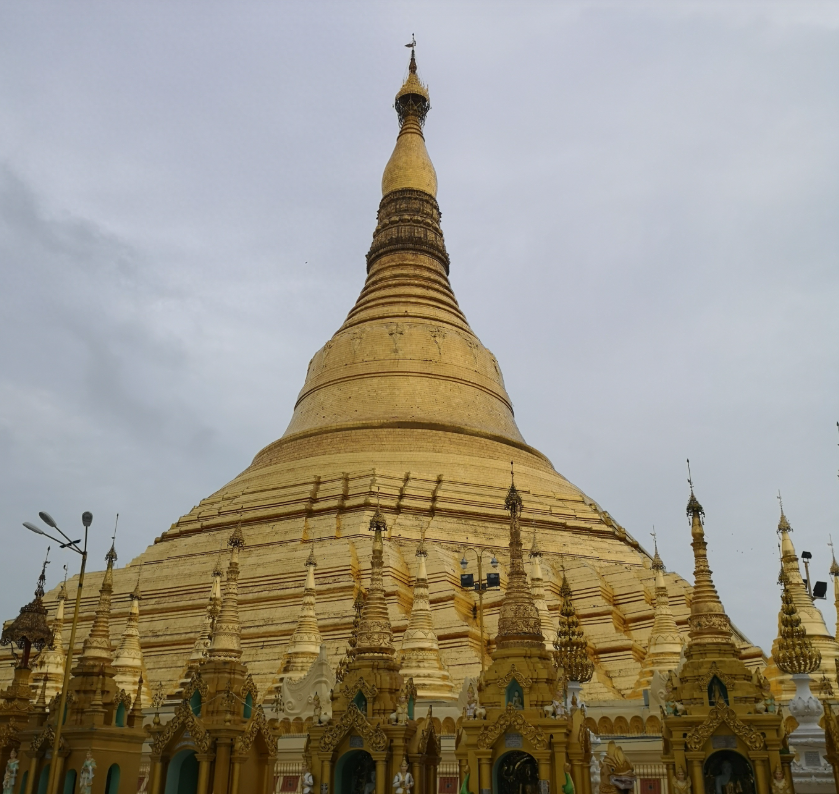If you’ve ever traveled to Myanmar, chances are you’ve visited the world-famous Shwedagon Pagoda in Yangon. As one of the three most sacred Buddhist sites in the country, this golden pagoda draws thousands of visitors every day. Pilgrims and tourists alike come to admire its grandeur, pray, or simply experience its deep spiritual significance. With such a rich history and breathtaking beauty, let’s take a closer look at what makes Shwedagon Pagoda so special.
A Historical Treasure
Also known as the Great Dagon Pagoda or the Golden Pagoda, the Shwedagon Pagoda’s history stretches back over 2,500 years. Legend has it that two Mon brothers met the Buddha and received eight of his sacred hairs, which they brought back to Myanmar. With the help of the local king, these relics were enshrined on Singuttara Hill, and a 20-meter-high stupa was built. Over centuries, the structure was rebuilt and expanded, now standing at an impressive 112 meters. Today, in addition to the Buddha’s hairs, the pagoda houses three other sacred relics: the staff of Kakusandha Buddha, the water filter of Konagamana Buddha, and the robe of Kassapa Buddha.

One intriguing fact about Shwedagon Pagoda is that it has never been designated as a UNESCO World Heritage Site. The reason? Continuous renovations and expansions over the centuries have made it difficult to classify as an original, untouched historical structure.
Entering the Pagoda: Traditions and Etiquette
If you’re planning a visit, there are a few things you need to keep in mind. First, you must remove your shoes before stepping onto the sacred grounds. Many visitors leave their shoes in their cars or at the entrance, but be cautious—since so many people visit daily, there’s always a risk of mix-ups.
Second, dress modestly. Men should avoid wearing shorts, while women should refrain from wearing skirts or tight-fitting pants. If you forget, don’t worry—longyis (traditional Burmese wrap skirts) are available for rent at the ticket counter. These rules are common in many religious sites worldwide, so it’s always good to be prepared when visiting sacred places.
The Majestic Guardian Beasts
Before stepping inside, you’ll be greeted by massive Chinthe statues—mythical lion-like creatures that guard the entrance. These gold-colored beings with black whiskers and yellowish bodies may remind you of Chinese guardian lions, but they are uniquely Burmese. The southern entrance is particularly striking, featuring a Chinthe with a human-like face, reminiscent of the Great Sphinx of Giza—but with a distinct Southeast Asian twist.
A Golden Wonder
As you ascend the stairs or take the elevator up, you will finally lay eyes on the magnificent golden stupa. The first reaction? Pure awe. The entire structure is covered in real gold, not just gold paint. This dazzling effect is even more spectacular at night when floodlights illuminate the pagoda, making it visible from various points across Yangon.
The gold is not just for show—Shwedagon Pagoda’s gold covering is regularly maintained and even replaced. Many devout Buddhists donate gold plates to be added to the pagoda, an act of great religious merit. In 2018, a major restoration took place, as reports surfaced that some contractors had mixed impure gold in previous renovations. Whether true or not, the temple remains a symbol of Myanmar’s deep-rooted Buddhist devotion.
The Hidden Wealth at the Top
Aside from its golden exterior, the pagoda’s pinnacle holds an extraordinary secret—a collection of priceless gemstones. The topmost part, known as the hti, is adorned with thousands of diamonds, rubies, and sapphires. At the very tip sits a massive 76-carat diamond. Due to this immense value, drones are strictly prohibited around the pagoda to prevent any security threats.
A Sacred Atmosphere
Surrounding the main stupa, you’ll find numerous smaller temples, Buddha statues, and shrines. Devotees kneel in prayer, lighting incense and offering flowers. You may also notice seven animal statues scattered around the area—these represent the days of the week. According to Burmese astrology, each day is associated with a particular animal, and visitors often pour water over the statue corresponding to their birth day as a ritual for good fortune and well-being.
One interesting feature is a massive tree on the temple grounds. Some believe it symbolizes the Bodhi tree under which the Buddha attained enlightenment. While its origins are uncertain, it adds an extra layer of spiritual depth to the site.
Mysterious Restrictions and Cultural Significance
Foreigners and even local women are not permitted to enter the inner chambers of the pagoda. The reasons for this remain unclear, as religious customs and beliefs can be complex and deeply rooted in tradition. Some speculate that the relics housed within the pagoda are too sacred to be viewed by certain groups. Regardless, the site remains a deeply revered place for both locals and visitors.
A Must-Visit Destination
Whether you are a devout Buddhist or just a traveler eager to explore Myanmar’s cultural heritage, the Shwedagon Pagoda is a must-visit. Its golden brilliance, historical depth, and spiritual atmosphere leave a lasting impression on all who step foot on its grounds. For Buddhists, it’s a place of deep faith and devotion; for tourists, it’s an architectural marvel and a glimpse into Myanmar’s rich history. Whatever your reason for visiting, one thing is certain—Shwedagon Pagoda will stay with you long after you leave.

No comments yet.